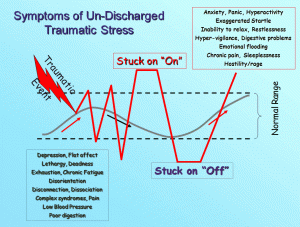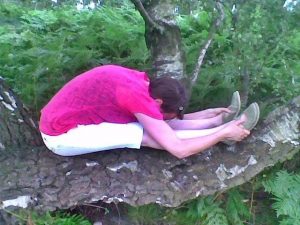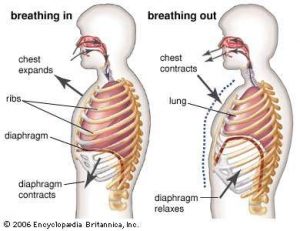In order to help with the symptoms of trauma we need to think of the trauma response as being an accelerator. I often remind my clients that trauma is something our body does. Our body has floored the accelerator pedal (so to speak) and we have forgotten that we even have a brake.
Trauma as undischarged energy
Trauma is our body’s natural response to an unnatural situation. Think of the tiny mouse who gets pounced on by the cat. Suddenly it is trapped in sharp jaws and knows it might die. A huge surge of energy rushes through its body as accelerator hormones are released that pump blood and expand lung capacity. It is like a nuclear bomb went off inside its body. This energy prepares the mouse to flee at the first opportunity (or fight if this was a larger animal). The moment the cat drops the mouse it runs faster than it ever has to survive. And the energy bomb is dissipated. The ‘hyper-arousal’ of trauma has served its purpose.
Fall asleep
Sometimes something else happens. When released from the jaws of hell, the mouse looks like it is dead. The animal feigns death. This is less well known side of the trauma response – ‘to fall asleep’. Many animals do this as a survival mechanism. It lies on the floor completely dead. The cat walks away. But the moment the mouse senses a millimetre of safety, it springs up and races off. However, if you were to watch closer, for longer, at some point you would see the little creature jerk and throw itself around in a strange sort of way. This is the mouse discharging the energy of the trauma response. This discharge means the mouse can get back to its normal life with no lasting after effects from the nuclear bomb which has just gone off inside of it.
Symptoms of undischarged trauma
Humans are often not so fortunate. Our natural instincts can be interrupted by our logic and our higher mind. Practically, this means that we are often left with the symptoms of undischarged trauma in our bodies that stay with us long after the traumatising event. In fact, they may lie dormant, but only until another trauma event triggers this energy again.
 Diagram: (Levine, Ogden, Siegel)
Diagram: (Levine, Ogden, Siegel)
This diagram is commonly used to help us understand heightened brain/body reactions during adversity. The dotted lines show a healthy nervous system. This being one which is able to self-regulate and maintain an arousal level (following a difficult event) that is within manageable or normal levels. When we experience trauma, this can induce a heightened energetic response in our system (as described above) and can mean that our ability to self-regulate is compromised. This is more likely to be the case if we have had earlier trauma, including disruptions in our early attachment needs.
From Hyper to hypo
This response to trauma pushes us into one of two states, which we will inevitably fluctuate between. Hyperarousal (the ‘stuck on’ position) is where our sympathetic nervous system is in charge and is characterised by an excessive energy response. This will present itself in symptoms of anxiety, panic, fear, hypervigilance and emotional flooding. We may feel rage or anger, restless and hyperactive and it will be difficult to eat, sleep or concentrate.
However, human beings cannot maintain this state for too long. Our system takes over and plunges us into the exhausted state of hypo arousal. This is where the parasympathetic nervous system takes over and in particular the dorsal vagal complex of the vagus nerve. Effectively this is the equivalent of the animal’s ‘feign death’ mode. Here we will feel depressed and tired, have more feelings of negativity and worthlessness, feel disoriented and disconnected. A sense of flatness or numbness will take over and we won’t feel like doing anything, we may also sleep a lot. Indeed we may even feel we don’t have a future. We are, in effect, emotionally dead.
Fluctuating between extremes
Again, our bodies won’t let us stay here too long. So we may be driven to risky (even suicidal) behaviour to feel alive again.
What I often find is that people often find one state more intolerable than the other, and therefore have more of a default position of ‘switched on’ or ‘switched off’. It goes without saying that both of these extremes are confusing and disturbing to us, and to those around us. People say ‘I feel like I am going mad’, they feel messed up and long to be normal. It is a chaotic state. Of course, this layer of shame doesn’t help.
Understanding the energetic response
Nevertheless, understanding the science behind this response helps to understand the disturbing nature of these symptoms. It is vital to learn to build resources in our self that will help us to manage the chaotic nature of undischarged trauma. This will help to protect us (and others) from further harm.
Risky behaviour increases with the trauma response
Without learning how to ‘self-regulate’ we will be at risk from taking actions that somehow help us manage these states but cause us more problems. We may take an overdose if we are so frightened by the thought of carrying on with these symptoms. We may smoke or drink more to help alleviate some of the distress, or become addicted to some other process or substance. These are more risky ways of managing the post-traumatic symptoms that lead to more shame, which will only feed the cycle.
Taking refuge in our self
Our body, and unconscious mind, already have all the resources within them to help us self-regulate the trauma response and find safety. By learning, or being reminded about, the resources we have within we can find and apply the brake on trauma. We can learn when to apply the accelerator and when to use the brake to steer our self into safety.
Applying the brake and the accelerator
Whilst there are different techniques to use for the hyper state and the hypo state, there is one that can work well for either. There is a muscle inside the middle of our body, which attaches to the heart via a central tendon, and also links up with the ventral vagal complex of the vagus nerve. In short, this muscle helps to engage the newest branch of the parasympathetic nervous system – the ‘smart vagus’ – the self-regulation centre. This muscle is the diaphragm, the primary muscle of respiration.
However we cannot just breathe our way out of trauma we have to do it in a very specific way. If we can learn to breathe using the full range (25-30 cm ) of our diaphragm, through our nostrils at a rate of around five breaths a minute (that is a 12 sec breath in and out) we can find a balance point between the brake and the accelerator. For this balance, certainly to begin with, there should be no pauses at the end of the inhalation or exhalation, just a smooth flowing of in-breath into out-breath. Like an undulating wave. It is from here that we can reach coherence and begin to find ‘normal’ again.
A simple practice to achieve coherence and balance
I usually teach my clients to reach this state in a number of steps. But I usually start by teaching them to find and engage with their diaphragm.
The following is a simple practice and the best way to do this:
Listen to a podcast of the practice here.
- Lie on the floor on your front with your body in a straight line. (it is important that you lie on a hard surface rather than a bed).
- Bend your arms at your elbows and rest your forehead or side of your face on your hands.
- Make sure you allow a few moments to get as comfortable as possible here.
- Make sure your mouth is closed, lips together, and you are breathing through your nostrils.
- Be aware of your body lying on the floor and the contact between your body and the floor.
- Become aware of your breathing, and notice your abdomen pushing into the floor as you breathe in. It releases as you breathe out.
- Keep your awareness on this feeling of your belly pushing into the floor as you breathe.
- After a few minutes, you can start to exaggerate this movement and push your belly even more into the floor by drawing deeper breaths. (if at any point you feel uncomfortable or have dizziness stop for a moment and come back to the practice later).
- Continue this practice for as long you can. And repeat every day if possible for a while.
Changing default habits
Remember that the trauma response is a habit that our body has gotten into when it is triggered. You can begin to change any pattern if you practice the new resourceful behaviour for a minimum 20 minutes for a minimum of 21 days (I usually say a month, continuously, with Sunday off!). This is like restoring your mobile phone to its factory default settings. You remember to breathe how you were born to breathe. You take the first step at re-connecting with the resources within that are your human heritage as an embodied being.
This article was first published on Counselling Directory.


